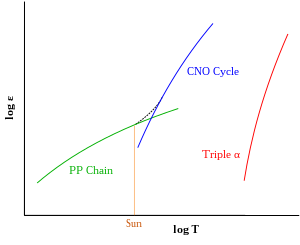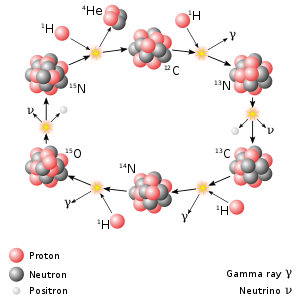
Back CNO-siklus Afrikaans دورة كربون-نيتروجين-أكسجين Arabic কার্বন-নাইট্রোজেন-অক্সিজেন চক্র Bengali/Bangla Cicle CNO Catalan CNO cyklus Czech CNO-cyklus Danish Bethe-Weizsäcker-Zyklus German Κύκλος CNO Greek Ciclo CNO Spanish Bethe tsükkel Estonian

The CNO cycle (for carbon–nitrogen–oxygen; sometimes called Bethe–Weizsäcker cycle after Hans Albrecht Bethe and Carl Friedrich von Weizsäcker) is one of the two known sets of fusion reactions by which stars convert hydrogen to helium, the other being the proton–proton chain reaction (p–p cycle), which is more efficient at the Sun's core temperature. The CNO cycle is hypothesized to be dominant in stars that are more than 1.3 times as massive as the Sun.[1]
Unlike the proton-proton reaction, which consumes all its constituents, the CNO cycle is a catalytic cycle. In the CNO cycle, four protons fuse, using carbon, nitrogen, and oxygen isotopes as catalysts, each of which is consumed at one step of the CNO cycle, but re-generated in a later step. The end product is one alpha particle (a stable helium nucleus), two positrons, and two electron neutrinos.
There are various alternative paths and catalysts involved in the CNO cycles, but all these cycles have the same net result:
- 4 1
1H
+ 2
e−
- → 4
2He
+ 2
e+
+ 2
e−
+ 2
ν
e + 3
γ
+ 24.7 MeV - → 4
2He
+ 2
ν
e + 7
γ
+ 26.7 MeV
- → 4
The positrons will almost instantly annihilate with electrons, releasing energy in the form of gamma rays. The neutrinos escape from the star carrying away some energy.[2] One nucleus goes on to become carbon, nitrogen, and oxygen isotopes through a number of transformations in a repeating cycle.

The proton–proton chain is more prominent in stars the mass of the Sun or less. This difference stems from temperature dependency differences between the two reactions; pp-chain reaction starts at temperatures around 4×106 K[3] (4 megakelvin), making it the dominant energy source in smaller stars. A self-maintaining CNO chain starts at approximately 15×106 K, but its energy output rises much more rapidly with increasing temperatures[1] so that it becomes the dominant source of energy at approximately 17×106 K.[4]
The Sun has a core temperature of around 15.7×106 K, and only 1.7% of 4
He
nuclei produced in the Sun are
born in the CNO cycle.
The CNO-I process was independently proposed by Carl von Weizsäcker[5][6] and Hans Bethe[7][8] in the late 1930s.
The first reports of the experimental detection of the neutrinos produced by the CNO cycle in the Sun were published in 2020 by the BOREXINO collaboration. This was also the first experimental confirmation that the Sun had a CNO cycle, that the proposed magnitude of the cycle was accurate, and that von Weizsäcker and Bethe were correct.[2][9][10]
- ^ a b Salaris, Maurizio; Cassisi, Santi (2005). Evolution of Stars and Stellar Populations. John Wiley and Sons. pp. 119–121. ISBN 0-470-09220-3.
- ^ a b Agostini, M.; Altenmüller, K.; et al. (The BOREXINO collaboration) (25 June 2020). "Experimental evidence of neutrinos produced in the CNO fusion cycle in the Sun". Nature. 587 (7835): 577–582. arXiv:2006.15115. Bibcode:2020Natur.587..577B. doi:10.1038/s41586-020-2934-0. PMID 33239797. S2CID 227174644.
- ^ Reid, I. Neill; Hawley, Suzanne L. (2005). "The structure, formation, and evolution of low-mass stars and brown dwarfs – Energy generation". New Light on Dark Stars: Red dwarfs, low-mass stars, brown dwarfs. Springer-Praxis Books in Astrophysics and Astronomy (2nd ed.). Springer Science & Business Media. pp. 108–111. ISBN 3-540-25124-3.
- ^ Schuler, S.C.; King, J.R.; The, L.-S. (2009). "Stellar Nucleosynthesis in the Hyades open cluster". The Astrophysical Journal. 701 (1): 837–849. arXiv:0906.4812. Bibcode:2009ApJ...701..837S. doi:10.1088/0004-637X/701/1/837. S2CID 10626836.
- ^ von Weizsäcker, Carl F. (1937). "Über Elementumwandlungen in Innern der Sterne I" [On transformations of elements in the interiors of stars I]. Physikalische Zeitschrift. 38: 176–191.
- ^ von Weizsäcker, Carl F. (1938). "Über Elementumwandlungen in Innern der Sterne II" [On transformations of elements in the interiors of stars II]. Physikalische Zeitschrift. 39: 633–646.
- ^ Bethe, Hans A. (1939). "Energy Production in Stars". Physical Review. 55 (1): 541–7. Bibcode:1939PhRv...55..103B. doi:10.1103/PhysRev.55.103. PMID 17835673.
- ^ Cite error: The named reference
Bethe-1939-bwas invoked but never defined (see the help page). - ^ Agostini, M.; Altenmüller, K.; Appel, S.; Atroshchenko, V.; Bagdasarian, Z.; Basilico, D.; Bellini, G.; Benziger, J.; Biondi, R.; Bravo, D.; Caccianiga, B. (25 November 2020). "Experimental evidence of neutrinos produced in the CNO fusion cycle in the Sun". Nature. 587 (7835): 577–582. arXiv:2006.15115. Bibcode:2020Natur.587..577B. doi:10.1038/s41586-020-2934-0. ISSN 1476-4687. PMID 33239797. S2CID 227174644.
This result therefore paves the way towards a direct measurement of the solar metallicity using CNO neutrinos. Our findings quantify the relative contribution of CNO fusion in the Sun to be of the order of 1 per cent;
- ^ "Neutrinos yield first experimental evidence of catalyzed fusion dominant in many stars". phys.org. Retrieved 26 November 2020.
Pocar points out, "Confirmation of CNO burning in our sun, where it operates at only one percent, reinforces our confidence that we understand how stars work."